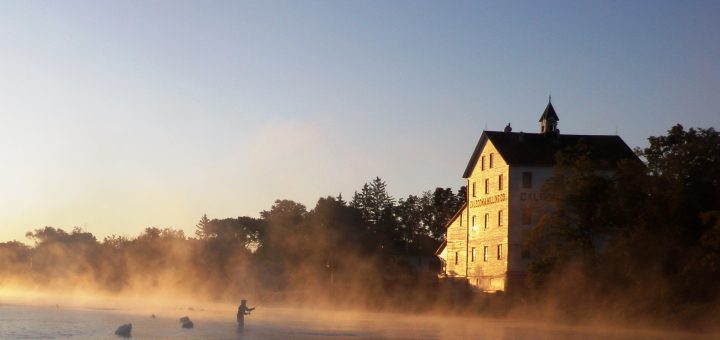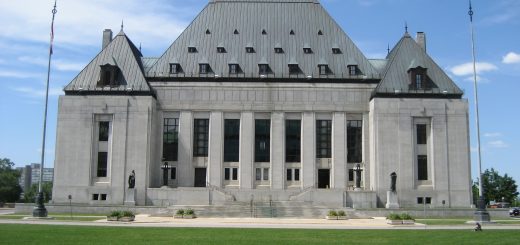Foxgate Development Inc v Jane Doe: On Injunctions, Colonialism, & Canadian Sovereignty

The Haldimand Tract is the site of a contentious and ongoing land dispute between the Six Nations of the Grand River (“Six Nations”) and the Canadian government. The Haldimand Treaty of 1784 granted a large parcel of land to Six Nations, including what is now Caledonia and Haldimand County (Justin Chandler, “Broken Promises, Unceded Land”; APTN National News, “Conflict in Caledonia”). The federal government claims that in 1841, Six Nations surrendered a portion of this land to the Crown; however, Six Nations claims that this land was unjustly taken away from them through European settlement beginning in the early 1800s . The disputed land has led to a number of conflicts over the last 200 years—most recently, the conflict over Foxgate Development Inc.’s (“Foxgate”) proposed McKenzie Meadows housing development, which was recently adjudicated in Foxgate Development Inc v Jane Doe, 2021 ONCA 910 [Foxgate].
Ontario Superior Court of Justice Decisions
In 2015, Foxgate purchased lands in Haldimand County for the purpose of developing housing. In July 2020, members and land defenders of Six Nations began occupying a construction site at the proposed development, naming it 1492 Land Back Lane. Their occupation prevented Foxgate from engaging in construction on the land.
In an attempt to begin construction, Foxgate sought an injunction to prevent the land defenders from obstructing the land in question. Haldimand County also sought an injunction to have barricades removed from a street in Caledonia. Both injunctions were successful, but the land defenders continued occupying the lands and refused to let Foxgate or its affiliated workers onto the property. In August 2020, Foxgate sought an order to continue the injunction, and sought to add Mr. Skyler Williams as a party to the injunction, characterizing him as a “protest leader” (Foxgate, para 11). Justice Harper, the motion judge, agreed to add Mr. Williams as a party, and denied a lawyer acting on Mr. Williams’ behalf a 24-hour adjournment to review the materials before rendering his decision. This lawyer was acting on Mr. Williams’ behalf, but was not formally retained, and Mr. Williams remained self-represented through the rest of the proceedings.
At the next court date, Mr. Williams “made clear that he was not abiding by the interim injunction that had been ordered and did not intend to comply with further court orders” (Foxgate, para 17). Although Foxgate did not bring a motion to strike Mr. Williams’ participation in the proceedings due to this non-compliance, Justice Harper found, “on his own motion and based on inherent jurisdiction,” that Mr. Williams was in contempt of court, which constituted an abuse of process (Foxgate, para 19). As such, Justice Harper prevented Mr. Williams from continuing to participate in the court proceedings until he and “his followers” complied with the injunction and agreed to be bound by the orders of the court (Foxgate, para 19). At the subsequent hearing, Mr. Williams confirmed that his position had not changed, and that he had no control over the conduct of the other land defenders. Justice Harper struck Mr. Williams’ pleadings and granted Foxgate a permanent injunction. As part of this decision, he ordered costs of over $168,000 against Mr. Williams.
Ontario Court of Appeal Decision
Mr. Williams brought an appeal to the Ontario Court of Appeal (“ONCA” or the “Court”). The ONCA’s decision focused largely on whether Justice Harper erred in finding Mr. Williams in contempt of court without affording him the required procedural safeguard, and relatedly, whether Justice Harper erred in conflating his findings on contempt of court with abuse of process. The Court also addressed whether the costs award against Mr. Williams was unreasonable.
Ultimately, the ONCA decision, authored by Justice Lorne Sossin, allowed Mr. Williams’ appeal, finding that Justice Harper failed to afford Mr. Williams the required procedural fairness before preventing him from participating in the proceedings. Justice Sossin pointed to several of Justice Harper’s errors that denied Mr. Williams the procedural fairness he was due. In addition to conflating abuse of process and contempt of court, Justice Harper failed to afford Mr. Williams the proper procedural safeguards required for either allegation. For instance, he did not specify what conduct of Mr. Williams’ was allegedly contemptuous—whether it was his past violations of the injunction, his statement that he would not abide by future orders, or his supposed influence over the other protestors violating the injunction. He did not provide Mr. Williams with any information on the legal requirements for contempt, nor its potential consequences. Further, by striking Mr. Williams’ affidavits, Justice Harper did not allow Mr. Williams to make submissions in his own defence, including submissions that engaged broader questions of Indigenous and constitutional law. Because Mr. Williams’ right to procedural fairness was violated by Justice Harper’s order, Justice Sossin concluded that the order striking Mr. Williams’ pleadings must be set aside.
Additionally, Justice Sossin found the $168,000 cost award against Mr. Williams to be problematic for three reasons. First, the cost award had included time the respondents spent on the injunction before Mr. Williams was added as a party, for which Justice Sossin held Mr. Williams could not be responsible. Second, Justice Sossin found the amount ordered to be “inordinate” (Foxgate, para 65). Finally, Justice Sossin held that the denial of procedural fairness in preventing Mr. Williams from making submissions regarding costs undermined Justice Harper’s decision. Accordingly, Justice Sossin concluded that Justice Harper erred in making his cost award against Mr. Williams.
Analysis: Injunctions & Conflicting Legal Obligations
Justice Sossin penned an important decision in Foxgate that helped mitigate some of the harm that Justice Harper’s decision had caused. By striking Mr. Williams’ submissions and issuing an extremely high costs award against him, Justice Harper’s decision contributed to the ongoing devaluation that Indigenous people face at the hands of the Canadian legal system. Further, by failing to abide by the appropriate procedural safeguards, Justice Harper’s decision undermined access to justice, as Mr. Williams, a self-represented litigant, was forced to navigate new, complex Canadian legal proceedings without the assistance of counsel and without necessary information about the allegations he was facing. In a time when legal services are increasingly unaffordable, failure to ensure self-represented litigants have the necessary information to represent themselves undermines the authority of the legal system as a whole.
While Justice Sossin’s decision remedies the specific concerns that Justice Harper’s decision created, this decision and the corresponding proceedings also raise broader concerns about the Canadian legal system, its colonial origins, and how Indigenous peoples in Canada can navigate conflicting legal obligations.
Throughout his court appearances, Mr. Williams repeatedly raised concerns with the jurisdiction of Canadian courts to issue and enforce an injunction against him. In one affidavit, Mr. Williams stated “I am a Haudenosaunee man who does not belong before this colonial court,” and explained that he was acting in accordance with the Haudenosaunee Great Law of Peace (Foxgate Developments Inc v Doe et al, 2020 ONSC 6529, paras 60-61, 111). His affidavit points to a broader, more complex question than those resolved on appeal—what can be done when Canadian law directly conflicts with Indigenous law?
This question has arisen in other instances of Indigenous people violating injunctions. As Professors Shiri Pasternak and Hayden King write, injunctions are a legal tool “used to remove Indigenous peoples from their land when communities contest the authority of provinces or territories to regulate, exploit, or sell lands without Indigenous consent” (Land Back: A Yellowhead Institute Red Paper, 30). Canadian courts frequently rely on injunctions to suppress Indigenous resistance and facilitate resource extraction from or development on Indigenous land. When land defenders do not comply with injunctions, they risk being found in contempt of court. These injunctions can often be at odds with obligations under Indigenous laws, and Indigenous people are forced to choose between complying with the injunction and abiding by their own legal systems.
For example, in Platinex v Kitchenuhmaykoosib Inninuwug First Nation, 2008 CanLII 11049 [Platinex] members of Kitchenuhmaykoosib Inninuwug First Nation violated an injunction ordering them to allow Platinex, a mining company, to access their land to mine, which ultimately resulted in six community members being found in contempt of court and sentenced to six months’ imprisonment. Interviews with the community members made it clear that they acted in accordance with, and compelled by, their own laws—particularly Kanawayandan D’aaki, the obligation to protect their land (Dayna Scott & Andrée Boiselle, “No Means No”, 236). In sentencing the community members, Justice Smith of the Ontario Superior Court of Justice (“OSCJ”) stated that he understood their “principles and beliefs” but that “the sanctity of the system of justice and of the rule of law are paramount and must be protected at all costs.” (Platinex, para 53).
Similarly, in Frontenac Ventures Corp v Ardoch Algonquin First Nation, 2008 ONCA 534 [Frontenac Ventures], members of the Ardoch Algonquin First Nation opposed Frontenac Ventures’ attempt to mine on their territory. When these members did not comply with a court-issued injunction, two land defenders, including Robert Lovelace, were charged with contempt of court. As a defence, Lovelace testified that Algonquin law prevented him from allowing Frontenac Ventures to mine, and thus from complying with the injunction. In response, Justice Cunningham of the OSCJ wrote:
Mr. Lovelace says that while he respects the rule of law, he cannot comply because his Algonquin law is supreme. He says he finds himself in a dilemma. Sadly it is a dilemma of his own making. His apparent frustration with the Ontario government is no excuse for breaking the law. There can only be one law, and that is the law of Canada, expressed through this court (Frontenac Ventures, para 40).
In both of these cases, as well as in Mr. Williams’ case, Indigenous defendants explained to Canadian courts that their actions were motivated by—and indeed compelled by—Indigenous laws. However, the courts rejected these explanations, and took for granted that they ought to have complied with Canadian law over Indigenous laws.
Is it fair, however, to expect Indigenous people to disobey their own community’s laws—which long predated the existence of the Canadian legal system—in order to avoid legal consequences imposed by the Canadian state? The Canadian legal system was imposed on Indigenous people through colonization. Despite the existence of longstanding systems of law governing Indigenous communities and nations, Canada “assume[d] jurisdiction” over Indigenous people, and required that they comply with laws it imposed on them (D’Arcy Vermette, “Colonialism and the Suppression of Aboriginal Voice,” 258). Given this history, there is a strong argument that it is fundamentally unjust to require Indigenous communities to abide by Canadian law when doing so violates their own long-standing legal traditions.
What recourse do Indigenous peoples have to contest the expectation that they subjugate and violate their own laws in order to comply with Canadian injunctions? Canadian courts, by their definition, must uphold Canadian laws. They are, after all, as Mr. Williams pointed out, a colonial creation—part of the very process of colonization and displacement that Indigenous land defenders are pushing back against. This conflict in laws dates back to the imposition of Canadian law on Indigenous communities, and as such, the Canadian legal system is deeply interconnected with Canada’s nationhood as a whole. Consequently, interrogating why Indigenous peoples can be forced to comply with injunctions that violate their own legal systems necessarily involves questioning Canadian sovereignty. While some courts have indicated a willingness to begin exploring these complicated questions (for example, see the recent decision in Thomas and Saik’uz First Nation v Rio Tinto Alcan Inc, 2022 BCSC 15), it seems unlikely that Canadian courts, as both a product and a perpetrator of colonization, can adequately address the conflict in laws that is apparent from cases like Foxgate, Platinex, and Frontenac Ventures, and inherent to the current structure of Canada as a nation.
[Original image: Fishing by the Caledonia Dam]








Join the conversation